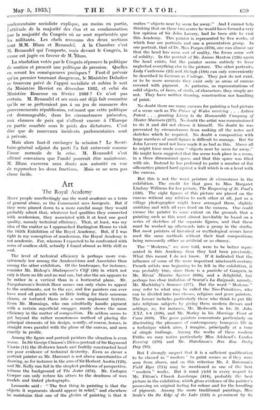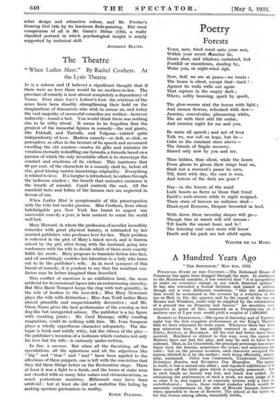Art
The Royal Academy
MANY people unreflectingly use the word academic as a term of general abuse, as the Communist uses bourgeois. But if they were pinned down to a more careful usage they would probably admit that, whatever bad qualities they connected with academism, they associated with it at least one good quality, namely technical efficiency. That, at least, was my idea of the matter as I approached Burlington House to visit the 165th Exhibition of the Royal Academy. But, if I was right in my conception of academism, the Royal Academy is not academic. For, whereas I expected to be confronted with acres of soulless skill, actually I found almost as little skill as soul.
The level of technical efficiency is perhaps more con- spicuously low among the Academicians and Associates than among the other exhibitors. Of the landscapes, for instance, consider Mr. Bishop's Shakespeare's Cliff (26) in which not only is there no life and no real sun, but also the sea appears to be rather in a vertical than in a horizontal plane. Mr. Farquharson's Scotish Moor scenes can only claim to appeal to the sentiments, not to the eye, and few painters can ever have used oil paints with so little feeling for their sensuous charm, or tortured them into a more unpleasant texture. Even Mr. Munnings, who can admittedly handle pigment with a certain superficial swagger, rarely shows the same efficiency in the matter of composition. He seldom seems to get beyond the rather monotonous method of placing the principal elements of his design, usually, of course, horses, in straight rows parallel with the plane of the canvas, and seen exactly in profile.
Among the figure and portrait painters the situation is even worse. In Sir George Clausen's lifeless portrait of Sir Raymond Unwin (11) the ill-drawn hands and faultily constructed head are poor evidence of technical dexterity. Even so clever a portrait painter as Mr. Harcourt is not above uncertainties of drawing, as for.instance in the arm of Sir Herbert Austin (126), and Mr. Kelly can fail hi the simplea problems of perspective, witness the baCkground of The Jester (378). Mr. Cadogan Cowper can only reduce his sitters to the deadness of wax models _and tinted photographs.
Leonardo 'said : " The first thing in painting is that the objects it represents _should appear in relief,"- and elsewhere he maintains that one of the glories of paintin,g. is that it makes " objects near by seem far away." And I cannot help thinking that on these two scores he would have formed a very low opinion of Sir JOhn Lavery, had he been able to visit this Academy. This painter is represented by five works, of which four are portraits and one-a presentation group. In one portrait, that of Dr. Max Porges (370), one can almost say that the head has some sort of reality, the forms some sort of solidity. In the portrait. of Mr. James Maxton (226) again the head exists, but the painter seems entirely to have neglected everything else in the picture. The other portraits, Lady Castlerosse (23) and Shelagh (188) can only conveniently be described in German as Undinge. They just do not exist, or to be more accurate they exist only as areas of canvas covered with pigment. As patterns, as representations 'of solid objects, of faces, of stuffs, of characters, they simply are not. They have neither drawing, construction nor handling of paint.
No doubt there are many excuses for painting a bad picture of a scene such as The Prince of IVales receiving . . . Letters Patent . . . granting Livery to the Honourable Company of Master Mariners (217). No doubt the artist was commissioned to do it and did not choose it himself. No doubt he was prevented by circumstances from making all the notes and sketches which he required. No doubt a composition with large numbers of small figures is difficult to manage. But Sir John Lavery need not have made it as bad as this. Above all he might have made some " objects near by seem far away." He might have suggested that the scene took place in a room, in a three dimensional space, and that this space was filled with air. Instead he has preferred to paint a number of flat silhouettes pinned hard against a wall which is on a level with the canvas.
But this is not the worst peinture de circonstance in the exhibition. The credit for that goes to Miss Margaret Lindsay Williams for her picture, The Reopening of St. Paul's (439). The eight figures of this picture are placed on the canvas without any relation to each other at all, just as a village photographer might have arranged them, slightly smirking and with all eyes fixed on the camera. One could excuse the painter to some extent on the grounds that a painting such as this must almost inevitably be based on a series of sketches of the separate figures, and that these must be worked up afterwards into a group in the studio. But most painters of historical or mythological scenes have used the same methods without their final compositions being necessarily either so artificial or so clumsy.
The " Moderns," we were told, were to be better repre- sented in this Academy than they had been previously. What this meant I do not know. If it indicated that the influence of some of the more important nineteenth-century French artists was beginning to be felt in the exhibition, it was probably true, since there is a pastiche of Gauguin, in Mr. Rivaz' Maxine Spencer (638), and a delightful, but perhaps too close imitation of Seurat's La Baignade, namely, Mr. Mackinlay's Summer (277). But the word " Moderns " may refer to what may be called the Neo-Primitives, who can be divided into two classes, religious and genre painters. The former includes particularly those who think to put life into religious subjects by giving them modern dresses and settings, as, for instance, Mr. Medworth in his St. John XXI, 1-8 "(190), and Mr. Morley in his Marriage Feast at Cana (680). The genre painters concentrate particularly on illustrating the pleasures of contemporary bourgeois life in a technique which aims, I imagine, principally at a tone of simple badinage. Among the works of these modern Friths we may notice particularly Miss Adshead's London Evening (270) and Mr. Hutchison's Bus Row--Derby Day (93).
But I strongly suspect that it. is a sufficient qualification to be classed as " modern to paint scenes as if they were seen from above, and on this criterion Mr. J. Bateman's Field Byre (714) may be mentioned as one of the best " modern " works. But it must yield in every respect to Mr. Fitton's Church Landscape (418), probably the best picture in the exhibition, which gives evidence of the painter's possessing an original feeling for colour and for the handling of pigment. Among the more traditional paintings, Miss Scale's On the Edge of the Lake (129) is prominent by its sober design and attractive colour, and Mr. Procter's Growing Girl (44) by its luminous flesh-painting. But most conspicuous of all is Mr. Gunn's Delius • (192), a really dignified portrait in which psychological insight is amply supported by technical skill.
'ANTHONY BLUNT.











































 Previous page
Previous page